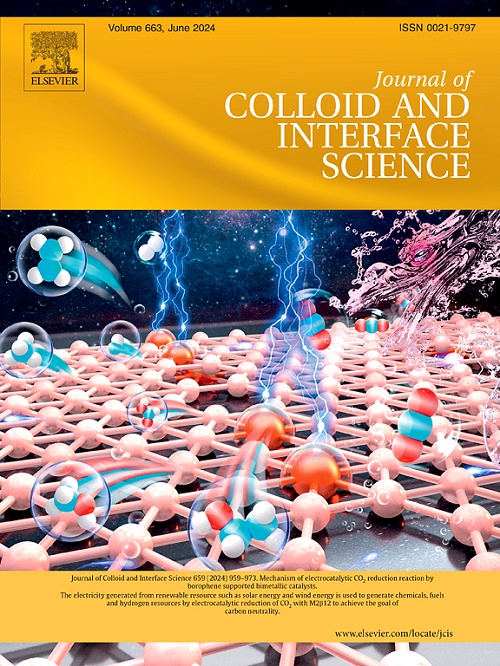锰铁氧体/锌铁氧体锚定石墨烯级联气凝胶光催化剂的构建及其在可见光驱动二氧化碳还原中的应用
IF 9.4
1区 化学
Q1 CHEMISTRY, PHYSICAL
引用次数: 0
摘要
本文采用溶胶-凝胶结合相分离的方法,实现了尖晶石型MnFe2O4 (MFA)与ZnFe2O4 (ZFA)之间的原子级界面耦合。然后通过乙二胺辅助水热自组装将这些复合材料固定在三维石墨烯气凝胶(GA)上,形成具有高表面积(191.06 m2/g)的分层多孔MFA/ZFA@GA。优化后的MFA/ZFA@GA在可见光下的CO产率为21.14 μmol·g−1·h−1(选择性96%,稳定性94%),比单组分体系提高了3.87倍。原位MFA/ZFA异质结和石墨烯增强的电子转移协同延长了10倍的光生电子寿命。分层孔隙还提高了CO2吸附性(7.66 wt%),明显的饱和磁化强度(37.49 emu/g)使磁分离恢复成为可能,*COOH监测证实了高CO选择性的快速脱附动力学。实验结合理论计算揭示了一个Z-scheme机制:MnFe2O4的还原电子(- 0.79 V vs. NHE)驱动CO2的还原,而ZnFe2O4的氧化空穴(1.50 V vs. NHE)促进H2O的氧化。异质结构、碳杂化和气凝胶结构的战略性整合为单片光催化剂的设计提供了有效的途径。本文章由计算机程序翻译,如有差异,请以英文原文为准。

Construction of manganese ferrite/zinc ferrite anchored graphene-based hierarchical aerogel photocatalysts following Z-scheme electron transfer for visible-light-driven carbon dioxide reduction
Herein, atomic-level interfacial coupling between spinel-type MnFe2O4 (MFA) and ZnFe2O4 (ZFA) was achieved via a sol–gel method combined with phase separation. These composites were then anchored onto a three-dimensional graphene aerogel (GA) through ethylenediamine-assisted hydrothermal self-assembly, forming a hierarchically porous MFA/ZFA@GA with a high surface area (191.06 m2/g). The optimized MFA/ZFA@GA exhibited a CO production rate of 21.14 μmol·g−1·h−1 (96 % selectivity, 94 % stability) under visible light, a 3.87-fold enhancement over single-component systems. The in-situ MFA/ZFA heterojunction and graphene-enhanced electron transfer synergistically prolonged photogenerated electron lifetime by 10 times. The hierarchical pores also boosted CO2 adsorption (7.66 wt%), the appreciable saturation magnetization intensity (37.49 emu/g) enabled magnetic separation recovery, and *COOH monitoring confirmed rapid desorption kinetics for high CO selectivity. Experiments combined with theoretical calculations revealed a Z-scheme mechanism: MnFe2O4’s reductive electrons (−0.79 V vs. NHE) drove CO2 reduction, while ZnFe2O4’s oxidative holes (1.50 V vs. NHE) facilitated H2O oxidation. Strategic integration of heterostructures, carbon hybridization, and aerogel architectures offered an efficient pathway for monolithic photocatalyst design.
求助全文
通过发布文献求助,成功后即可免费获取论文全文。
去求助
来源期刊
CiteScore
16.10
自引率
7.10%
发文量
2568
审稿时长
2 months
期刊介绍:
The Journal of Colloid and Interface Science publishes original research findings on the fundamental principles of colloid and interface science, as well as innovative applications in various fields. The criteria for publication include impact, quality, novelty, and originality.
Emphasis:
The journal emphasizes fundamental scientific innovation within the following categories:
A.Colloidal Materials and Nanomaterials
B.Soft Colloidal and Self-Assembly Systems
C.Adsorption, Catalysis, and Electrochemistry
D.Interfacial Processes, Capillarity, and Wetting
E.Biomaterials and Nanomedicine
F.Energy Conversion and Storage, and Environmental Technologies

 求助内容:
求助内容: 应助结果提醒方式:
应助结果提醒方式:


